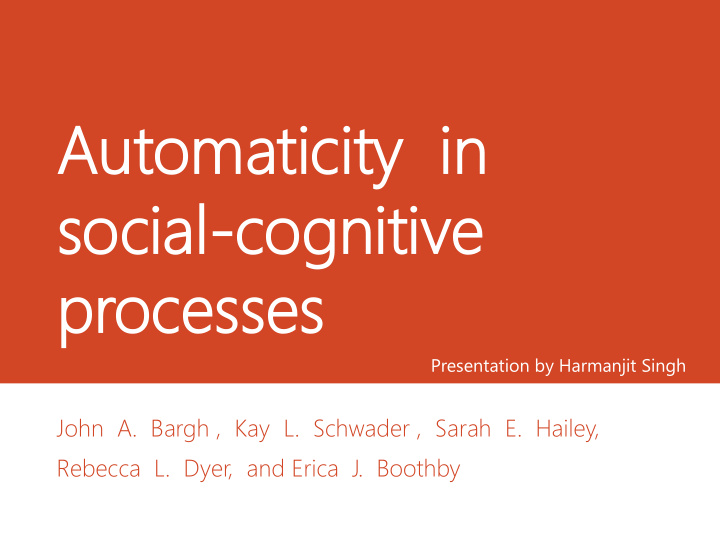



Au Auto tomatici maticity ty i in n so social cial-cogn cognitiv itive e pr proc ocesses esses Presentation by Harmanjit Singh John A. Bargh , Kay L. Schwader , Sarah E. Hailey, Rebecca L. Dyer, and Erica J. Boothby
Background • Some basic social-perceptual Bargh , J.A. processes could have unintentional (1989) components Bargh et al • Automatic reactions are learnt form (1997) experience Bargh, J.A. and • Innate processes exert automatic, non Morsella, E. conscious influence over higher cognitive processes (2008)
Background Types of Automaticity Post-conscious Pre-conscious Generated from effortless sensory “Goal -dependent or perceptual activity to then serve automaticity’’ as implicit, unappreciated inputs into conscious and deliberate processes, Dependent on prior or or directly activate higher mental concurrent conscious processes such as goal pursuit and and intentional thought social behavior
Preconscious automatic phenomena Automatic Influences Embodied cognition Internal Emotional influences Facial features Behavioral External contagion Expressions
Automatic processes observed in Infancy Domain Observations Object Solidity, rigidity, cohesive Number One core system for small quantities; one approximate system for numerical values Space Sensitive to distance, angles, and direction, Egocentic and allocentric frame of reference for navigation Agent Organize the actions of agents in terms of those agents’ goals Social evaluations Prefer prosocial to antisocial agents False beliefs Infants demonstrate false-belief understanding Priming Priming can induce social behavior Implicit attitudes Distinguish faces by gender and race
Mimicry Being mimicked by another person typically creates feelings of bonding (Chartrand, T.L. and Bargh, J.A. (1999), Study 2) and social warmth (as well as physical warmth; embodiment) Being mimicked by an out-group member has the opposite effect and actually ‘ leaves one cold’ (Leander, N.P . et al. (2012) ) Self-concept and positive feelings towards the target are necessary ingredients for mimicry and behavior contagion effects
Remnant-Mimicry Observation : People were more likely to behave in unscrupulous ways, such as littering, stealing, or disobeying posted signs, in contexts where there was evidence of past disorder (e.g., graffiti, litter). Conclusion : Behavior priming thus has real social consequences and can occur even in the absence of the original actors and the actual behavior being mimicked – when only vestiges of the relevant behavior remain. − Keizer, K. et al. (2008)
Facial perception Brief presentations of faces leading to spontaneous inferences about the trust-worthiness and competence of the target person − Todorov, A. et al. (2009) People are able to automatically infer the preferences of others from spontaneous facial expressions − Todorov, A. et al. (2005) People tend to rely too much on appearance when making these trait and other judgments, assigning facial appearance too much weight in subsequent decisions about the person than is merited − Olivola, C.Y. and Todorov, A. (2010)
Embodiment Strong associations between metaphorically related physical and psychological concepts 1 physical sensations of surface hardness prime more abstract • notions of difficulty 2 physical heaviness activates notions of seriousness 2 • briefly holding a warm cup of coffee produces feelings of • social warmth 3 prefer to wash their hands more after remembering a past • guilty behavior, as though they were ‘washing away their sins’ 4 1 Barsalou, L.W. (2008) ; 2 Ackerman, J.M. et al. (2010) ; 3 Williams, L.E. and Bargh, J.A. (2008) ; 4 Bargh, J.A. and Shalev, I. (2012)
Embodiment: Power Posing Power posing produces psychological and behavior changes such as increased feelings of power and risk tolerance, but it also produces neuro- endocrine changes by increasing testosterone (the dominance hormone) and decreasing cortisol (the stress hormone) − Carney, D.R. et al. (2010) Accordingly, high-power posers show increased confidence in decision making, as well as a preference for decision-consistent information − Fischer, J. et al. (2011) Power Posing : Incidental adoption of open and expansive bodily positioning
Physical Link of Abstract Social Process The more pan-cultural mechanisms, such as physical and social warmth and coldness, may be hard-wired 1 For example, experiences of social exclusion (social coldness) literally reduce bodily temperature (physical coldness) 2 Employ Principle of neural re-use 3 Social pain and distress caused by rejection experiences activates the same brain regions involved in the experience of physical pain 4 1 Kang, Y. et al. (2011); 2 IJzerman, H. et al. (2012); 3 Anderson, M.L. et al. (2012); 4 Eisenberger, N.I. et al. (2003)
T arriance Occasionally the sensory or perceptual experiences can be carry-over reactions from one context to the next, ( as in embodiment or moral judgment research, in which emotional disgust or guilt reactions influence subsequent information processing and behavioral responses)
Goal Driven Experiments Priming: Mating goal Topic A: less interesting Topic B: more interesting
Unconscious Thought Theory Proposed by Dijksterhuis and Nordgren Claim: Decisions made unconsciously are superior in quality to those made consciously Judgment relevant information acquired Conscious intention is formed to make the best decision A period of deliberation using unconscious thought (while conscious thought is directed elsewhere) produces better quality judgments than does an equally long period of conscious deliberation
Compromise Proposition A combination of both conscious and unconscious thought processes would solve complex problems better than either type by itself. − Nordgren, L.F. et al. (2011) Conscious Unconscious Conscious thought Aggregation Unconscious thought of the various Following decision rules relevant Best decision dimensions
Conclusion Skill acquisition is not the only route to Automaticity Any process of sufficient complexity to be of interest to social psychologists involves a complex interplay between both controlled (conscious) and automatic processes. Even before their first birthday, infants possess the cognitive machinery necessary to begin making sense of the physical and social world around them Conscious processes play an important causal role, capable of changing and redirecting the unconscious behavioral or judgmental impulse
Th Thank Y ank You ou References are provided immediately when the respective work has been cited.
Recommend
More recommend